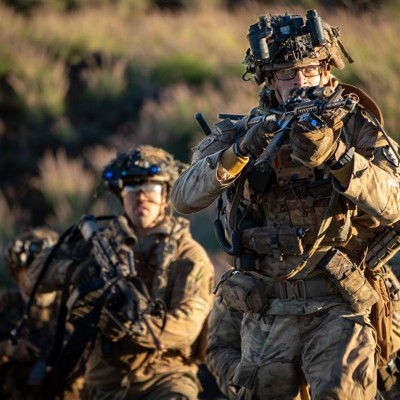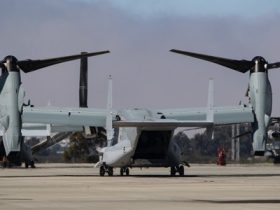The lone Pacific brigade chosen for the Army’s new equipment strategy is finding that the new tech has unique advantages for its terrain — as well as challenges, the unit’s commanding general said Friday.
The unit, the 2nd Brigade of the Hawaii-based 25th Infantry Division, is one of just three brigades selected for the Army’s “transforming-in-contact” strategy. The two others are the 101st Airborne Division’s 2nd Brigade and the 10th Mountain Division’s 3rd Brigade.
Under the strategy, units are given a range of new tech and told to figure out how to best use it at their home bases and in challenging field exercises. The Army has so focused on drone, counter-drone, and electronic warfare for the strategy, drawing in part on lessons from Ukraine.
In an exercise running Oct. 7 to 16 at the Joint Pacific Multinational Readiness Center, the unit brought as many as 150 small drones, said 25th Infantry Division commander Maj. Gen. Marcus Evans.
Those drones include around 130 Skydio drones fielded under the Army’s Short Range Reconnaissance program, plus Parrot and Teal drones, a 25th Infantry Division public affairs officer said. The Army also leased several Kraus K1000 drones, the spokesperson added.
That’s a lot more small drones than Army units have generally carried. The service only recently began acquiring such systems and so far has bought them in quantities of a few hundred a year—generally under the Short Range Reconnaissance Program.
Evans said the unit’s drones and electronic warfare units are seeing successes in the exercise. After spotting a “enemy” unit through electronic means, they tracked it with drones, and then called in a simulated loitering-munition strike.
The unit uses the Switchblade 600 loitering munition, which the Army acquires under the Low Altitude Stalking and Strike Ordnance, or LASSO, program.
Based on advice from the 101st’s 2nd Brigade and their own experience, the 25th’s 2nd Brigade has also increased the number of Starlink satellite terminals it uses, Evans said. The 19-by-12-inch dishes provide far faster transmission speeds than traditional Army satellite systems, while being much more portable and easier to hide.
The brigade is experimenting with three to four terminals that the commander can re-distribute as necessary, as well as two terminals per battalion. Sustainment assets also get Starlink terminals, Evans said.
The terminals are particularly useful for allowing sustainment efforts to disperse, thereby becoming harder to hit.
“They can’t all stay together, because they will be targetable,” he said.
Starlink devices are particularly important in the vast distances of the Pacific. One battalion, for example, is deployed 200 miles away from its brigade command, on a different island, Evans said.
The Starlinks allow the brigade to “overcome the tyranny of distance,” he said.
At the same time, some Pacific-related factors—like heat—play havoc with the very systems at the center of the “transforming-in-contact” experiment.
During a previous rotation to the Philippines, drones had “much less endurance” because heat drained their batteries, Evans said.
To get more power, the 25th Infantry is testing out a solar-powered generator that allows small light infantry units to recharge batteries used for drones and other systems, he said.
The Pacific rains also made problems for drones and mission command systems.
Fortunately, the 2nd Brigade has partners — the two other brigades that are also going through transformation-in-contact. Evans said the 2nd Brigade works closely with the 101st’s 2nd Brigade, and has duplicated many elements of how that unit has set itself up.
“Our collaboration with them has been nearly seamless from how we structure our network to how to employ deception measures,” he said.
Read the full article here








Leave a Reply